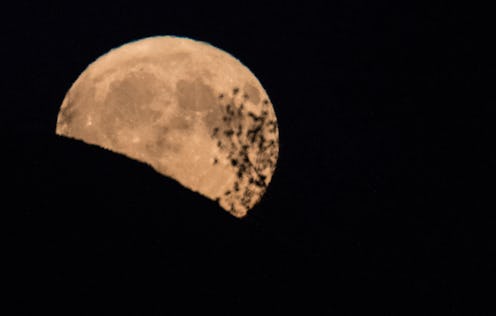Life
Here's Everything You Need To Know About The “Wolf Moon” Happening On New Year’s Day

I don't know about the rest of 2018, but January is getting off to a great start — as long as you like stargazing. Next year will kick off with two full moons in the first month, beginning on the night of Jan. 1. So what is the Full Wolf Moon, exactly, and what does it mean for the lives of us Earthlings? If you're the type to put stock in astrology, it's bound to influence your decisions in the coming weeks. Otherwise, it's an excuse to marvel at nature and humanity's place in the universe before getting back to all the "new year, new you" business.
According to the Old Farmer's Almanac, several Native American cultures kept track of the seasons by naming each moon phase throughout the year. These names roughly correspond to the 12 months: the Pink Moon takes place in April, the Strawberry Moon in June, and so on. Colonial Americans most commonly adopted the names used by the Algonquin culture, which extended from New England to Lake Superior at the time.
Depending on the culture, the first full moon of the year was sometimes known as the Old Moon or Snow Moon. The most common name associated with January's full moon, however, was the Wolf Moon, named for the days when wolves howled and scrabbled for food just outside town. Given that breeding season begins in January, wolves may have howled especially often during this time.
In 2018, the Wolf Moon will also be a supermoon, meaning the moon is at its fullest when it's also closest to Earth. This doesn't actually make much of a difference to the naked eye, although it may look a little brighter and bigger when viewed with a telescope. According to Space.com, the Wolf Moon will rise in North America at 9:24 p.m. on Jan. 1, and it will be found in the Gemini constellation. (Due to time differences, it won't rise until Jan. 2 in Europe and Asia.)
Traditionally, full moons are seen as a chance to start anew — time to reflect on your choices and forge a new path. It's especially poignant, then, that the Full Wolf Moon will rise on the first day of 2018. Take the night of Jan. 1 to figure out where you want the year to go, and formulate a plan to make those goals a reality. Forever Conscious also notes that full moons are associated with illumination, so prepare for some hard truths to come to light.
That's the lowdown on the Wolf Moon. The second full moon of the month, known as a blue moon, is an entirely different story. According to Space.com, it will rise on Jan. 30 and reach peak fullness on Jan. 31. Get this: The blue moon is also a supermoon, and it will feature a total lunar eclipse. This phenomenon occurs when Earth blocks the sun's light from reaching the moon, which has the eerie effect of turning the moon blood-red. According to Space.com, January's lunar eclipse will be visible from Asia, Australia, the Pacific Ocean, and the western United States.
Obviously, people wouldn't let something like a rust-colored moon pass without comment. A total lunar eclipse is called a Blood Moon, so the full moon on Jan. 31 has three different names: Supermoon, Blue Moon, and Blood Moon. I'm not saying the Wolf Moon should go home with its tail between its legs, but it's definitely going to be overshadowed.
If you're an avid stargazer, you won't want to miss out on January's lunar events — especially because February won't have a full moon at all. Don't forget to practice your howl for showtime on Jan. 1.